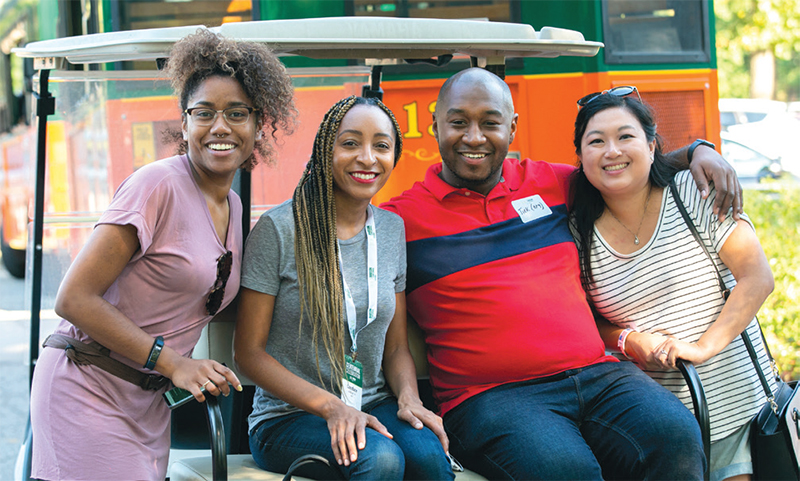
Alumni, faculty, staff, and friends gathered on campus for Back to Babson 2019, part of the Centennial Celebration in September. The record-breaking event, with more than 2,500 attendees, featured a Food & Wine Expo, a display of alumni-founded businesses, the Centennial Clambake at The Tent, and Reunion Class Parties.

Babson’s first women graduates celebrated their pioneering role in Babson’s history at a luncheon in September. The event, part of the weeklong Centennial Celebration, featured presentations from alumni, students, and the first female chair of the Board of Trustees, Marla Capozzi MBA’96.
See more stories and videos from Babson’s Centennial Celebration »
]]>
He was a Babson student, a professor, and an administrator, and now Spinelli is poised to lead the College, starting this summer.
Stephen Spinelli Jr. MBA’92, PhD Named Babson’s 14th President »
Breaking the Cycle of Incarceration

In professor Elizabeth Swanson’s human rights class, students work with inmates on entrepreneurial ventures that they can pursue once released.
Can Entrepreneurship Reduce Recidivism? This Babson Professor Says Yes »
Toyoda, Case Chosen as Commencement Speakers
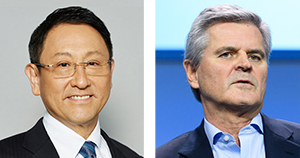
Renowned entrepreneurs Akio Toyoda MBA’82, P’14 of Toyota Motor Corporation and AOL co-founder Steve Case will deliver speeches at Babson’s 2019 Centennial Commencement.
Global Business Leader Akio Toyoda MBA’82 to Deliver Graduate Centennial Commencement Address »
Internet Pioneer Steve Case to Deliver Undergraduate Centennial Commencement Address »
The New Babson MBA Debuts
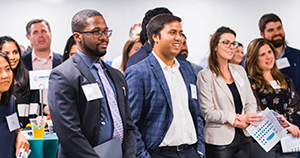
See how this updated MBA features customization options, more electives, intensity tracks, and is in tune with today’s job market.
Get to Know Babson’s New MBA »
Ken Matsuno Appointed Dean of Faculty

In his new role, the Marketing Division professor will head up full- and part-time faculty and serve on the President’s Cabinet, Academic Council, and the Operating and Finance Committee.
Dr. Ken Matsuno Named Babson’s Dean of Faculty »
The Campus Gets a New Park

Kerry Murphy Healey Park, named for the College’s 13th president, will feature the Babson Globe, Fountain of Flags, and a statue of Roger Babson.
Centennial Park to Be Named in Honor of President Kerry Healey »
Success Starts with a Coach

Getting an edge on career achievement starts with coaching and mentorship, says professor Joseph Weintraub, founder of the Coaching for Leadership Teamwork Program.
Making the Babson Experience Meaningful, One Coaching Session at a Time »
The Barefoots Endow Athletics Director Position
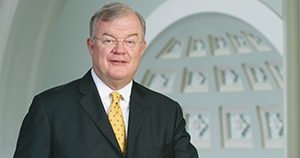
Babson president emeritus Brian M. Barefoot ’66, H’09, P’01 and wife Pamela P. Barefoot P’01 have donated $2 million to endow the Athletics Director position and inspire others.
Christine and Michael Angelakis Support Education
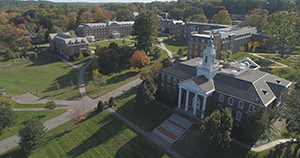
During Babson’s Centennial year, Christine ’86 and Michael Angelakis ’86 give a $6.8 million gift for financial aid and unrestricted support to the College.
Angelakis Family Gift Advances Entrepreneurship Education and Leadership »
]]>
Roger Babson
Roger Babson may have been a dedicated businessman during the week, but Sundays were set aside for church services and family suppers. As devoted as he was to this spiritual routine, one of his granddaughters recalls that entrepreneurship was never far from his mind.
Marlene Graf says that these weekend get-togethers included her grandfather “always bringing out a new project he had going.” Once, it was a box filled with faux diamonds. “He was always looking for a new investment, a new invention.”
Those who knew Babson recall a driven man who was both practical and sentimental, who loved his family, was deeply religious, and had a determination to help others succeed.
“Anybody could talk to him,” says Judy Webber Ross, Graf’s older sister, who remembers accompanying her grandfather as he stopped by the campus lunchroom to talk with students and staff. She adds that he encouraged empathy in others. Babson took her to a convalescent home in a building that eventually became part of the campus, one that at the time treated polio patients. “He wanted me to see what life was like for people who had polio.”
Katherine Babson Jr. MBA’77, H’99, was in junior high school when she asked Babson, her grandfather’s second cousin, to contribute an ad for her school magazine. “We had a nice discussion,” she says, “and he gave me a check for the ad. The check had his picture on the left side, and on the right side was a picture of Sir Isaac Newton.”
Babson made an impression on students as well. Jack Dewey ’49, P’80 attended Babson’s weekly Friday talks on campus where Babson offered students guidance on business and investments.
Dewey, who worked for Liberty Mutual and directs the annual scholarship award selection committee for the Class of ’49 Scholarship Fund, says his education included statistics, which he loathed. “When I finally got into management,” he says, “I started using statistics. I found out how valuable they were. So, Roger knew more about it than I did.”
And what would Roger Babson think about the campus today? Those who knew him say he would likely be surprised—but pleased—by the coed campus; stunned to see a pub that bears his name, given his stance on Prohibition; and thrilled at the College’s expanded curriculum and focus on entrepreneurship.
“I think the school has progressed further than probably he ever thought it would,” Dewey says. – Jeannine Stein
]]>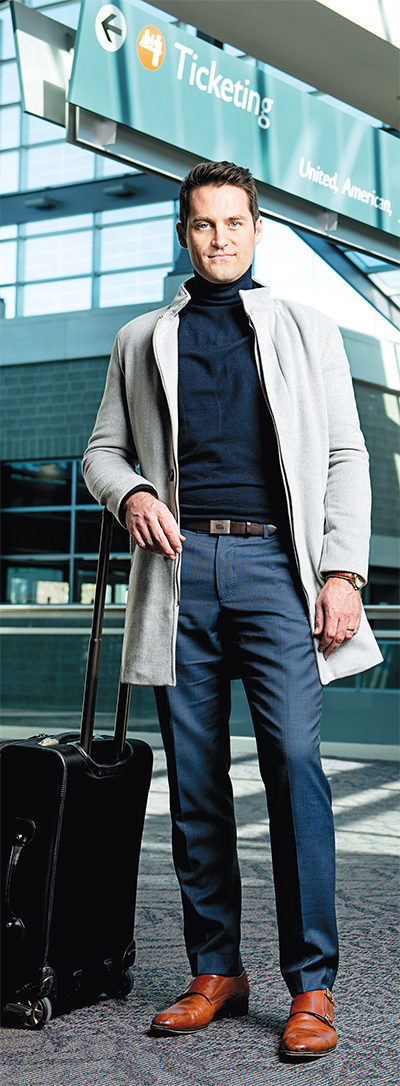
Ben Chevrette is Babson’s director of regional and international advancement.
Photo: Webb Chappell
Ben Chevrette is the very definition of a frequent flyer. As Babson’s director of regional and international advancement, he wings around the world, meeting with members of the College community to raise support for the institution. “I travel extensively, from South Africa, to many spots in Asia, to Europe, to Latin America,” he says. “There is no place we don’t have alumni and supporters of the College.” While all the traveling is exciting, Chevrette confesses to being a homebody. When not on the road, he likes spending time at home or on campus, where he often eats in Trim Dining Hall. “I see the students,” he says, “and I’m reminded what this is all for.”
Where have you been lately?
I just returned from India. You can’t find two places that are more different than Mumbai and Wellesley. I am reminded that our students from India have to adapt to a new culture, a new style of learning, and they excel. That’s a testament to the students we attract. And it’s a testament to my colleagues at Babson. They have created a welcoming environment, where students from any part of the world can excel.
What kind of reception do you receive during your visits?
There is red-carpet treatment for any Babson representative who travels internationally. People invite me to their homes, to their clubs, and introduce me to their families. I’ve never experienced a warmer reception. I’ve met with heads of state and CEOs of multinational corporations. The energy people have for this College is amazing.
How is that energy translating into support?
Babson’s average fundraising amount internationally used to be about $1.5 million a year. Last year, we raised $13 million.
What do you like about your job?
I have found a career in which I meet people and help them realize the type of impact they want to have. That’s rewarding. I think of Babson as a platform. People invest here to make change. There is no cause you can’t impact with Babson as your vehicle. Global health issues. Climate change. Really, anything. If you care about hunger, you can give to a food bank, and that will give food to people. That’s noble. But you can give to a school like Babson that trains entrepreneurs, who may address the causes of global hunger and find solutions. – John Crawford
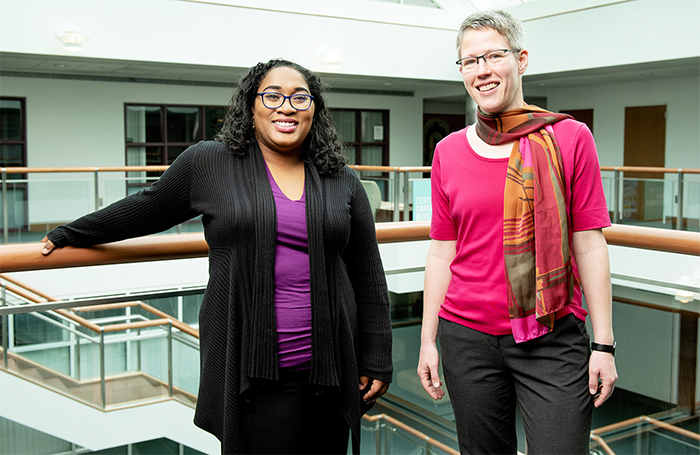
Photo: Webb Chappell
Janai Mungalsingh ’08 (left) and Katrin Fischer, MBA’15
Eager kids with open minds who are unafraid to take risks. That describes the students who typically enroll in Babson’s Summer Study for rising high school juniors and seniors, says Katrin Fischer, MBA’15, faculty director for the program and adjunct lecturer in arts and humanities.
The cohort of about 130 shares other traits. “I would say they’re naturally curious,” says Janai Mungalsingh ’08, Babson’s youth programs curriculum designer. Adds Fischer, “They have a kind of openness about the unknown, about new or unstructured experiences.”
During the four-week program, students spend mornings in the classroom; the emphasis is on Babson’s Entrepreneurial Thought & Action methodology. The course, taught by Babson faculty, covers topics ranging from business law to sustainability to presentation skills. This last one is key because, in true Babson fashion, the course builds toward a pitch of a business idea the students, working in groups, have developed. Along the way, they test their ideas, build prototypes, and receive feedback. Past student ventures have included Panana, which supports education in developing countries through sales of notebooks made from banana leaves, and Kover, a clear skin patch that allows users to sample beauty products in stores.
Afternoons are spent in activities that reinforce the morning’s lessons. These might include company site visits, networking events with local entrepreneurs, or student-run forums. Mungalsingh, who oversees this aspect of the program, notes that students often react to activities in ways that show their understanding of lessons learned in the classroom. “I get the pleasure of seeing those ‘aha moments,’” she says.
Admission to the program is competitive—the acceptance rate is around 33 percent—and students have come from about 37 countries. It might seem natural that many Summer Study participants eventually end up as Babson students, and, in fact, during the program’s eight-year history, about 10 percent of enrollees have matriculated at the College. But the program wasn’t designed to put Babson on the radar of prospective students, or vice versa. Mungalsingh says, “It was a way to create access to and share this methodology with young people everywhere.”
Participants gain valuable life skills, says Fischer. “Even if they do not go on to be entrepreneurs, we are all entrepreneurs of our own lives,” she notes. Students learn to cope with ambiguity, change, and failure.
Some students waste no time putting their skills to work. Mungalsingh recounts how, when construction limited use of the Webster Center, students—who wanted access to a gym—advocated for an arrangement with Boston Sports Clubs and negotiated a rate for the program. “And it was a great rate,” she says.
Students invariably offer enthusiastic feedback about the program, says Mungalsingh, who is equally ardent about her work with the students. “It’s energizing to see their passion, their dedication, their excitement,” she says.
But Mungalsingh is particularly pleased at the comments she hears from parents. “They call me and say, ‘What did you do to my child?’” she says. “‘They’re thinking for themselves, they’re doing their own thing, and they didn’t even ask me for help.’”—Jane Dornbusch
Applications for 2019 Summer Study are now open. The application closes March 1. Apply now »
]]>
Photo: Tony Rinaldo
Marla Capozzi, MBA’96, chair of the Babson Board of Trustees
In the fall of 2017, Marla Capozzi, MBA’96, became the first woman elected chair of the Babson Board of Trustees, joining President Kerry Healey, the first woman president of the College. A leader in McKinsey Academy, the arm of consulting giant McKinsey & Co. that helps businesses rethink their approach to employee leadership and development, Capozzi has been a member of the board since 2011. Her expertise is strategy and innovation, which she has shared with Babson in numerous ways, from mentoring to teaching to advising. Now she will use her talents to help lead Babson toward its Centennial celebration and prepare for a changing future.
What made you choose Babson for your MBA?
I was working at Lotus/IBM, and I was moving into a new position in the innovation center where I would be helping to launch new products. So I re-evaluated going to a full-time MBA program and wanted to go to the number-one school in entrepreneurship.
After graduating, how did you re-engage with Babson?
Initially, through professor Joe Weintraub’s Coaching for Leadership and Teamwork Program. At McKinsey, it’s all about coaching— our teams and our clients—and it wasn’t a skill that I felt I had mastered in my other roles. So I thought that I could give back and work on my own skills at the same time.
Who asked you to be a trustee?
Former President Len Schlesinger. When the announcement came that Len was going to be president, he had been a client of McKinsey. I hadn’t spoken to him directly, but I knew about him. So I sent him a message, and we met. He later called me and said, “If you have so many ideas about how to make Babson better, why don’t you come and help fix it? I’d like you to become a trustee.” So I thought, OK, let’s give it a shot, really having no idea what to expect.
What do you like about being a trustee?
I really enjoy governance, but more importantly the people—trustees, staff, faculty, and students—are all amazing. They just want to do the right thing and have a great impact. It’s what has kept me engaged and energized. It’s both a challenging and exciting time to be affiliated with higher education, given the disruptions in technology, the future of work, and the changing global market. But I also feel like we have a fantastic opportunity to change the world.
What does it mean to students and others to see a woman as chair?
It’s funny—at this point in time, I never thought I’d be the first woman to do anything. It seems crazy that this is still happening. But I have come to believe that it has huge meaning, given the fact that Babson was founded as a college for men, and it remained that way for about 50 years. Today, we are one of the most internationally diverse schools, and two of the last three classes were more women than men. We have our first woman president. This level of diversity of all kinds is an important message to the world about Babson and what we value.
What are some of your goals as chair?
As part of our upcoming Centennial, we need to consider the past, present, and future vision for the College. The past grounds us and gives us an opportunity to reflect. Roger Babson founded this college with the intent of teaching business leaders differently, and out of that came the creation of the discipline of entrepreneurship. He also believed that business should be rendered in service of humanity, and those strong beliefs are with us today. Now we are leaders in entrepreneurship. We need to determine the impact we want to have in the next 100 years, and how we prepare Babson for that future. We have been the first college to do many things, so as we move forward, I want to continue with this pioneering tradition. Also, as education evolves, we will have different types of learners interacting with the College in many ways, from undergraduates and graduates to online and global learners. We want every student to have a uniquely Babson experience that they can’t get anywhere else.—Donna Coco
]]>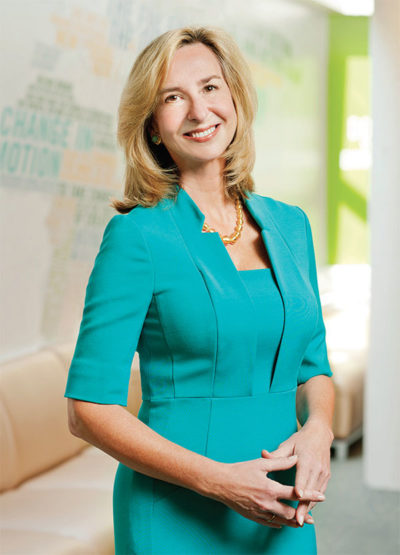
Photo: Webb Chappell
Babson President Kerry Healey
During the past several years, Babson’s incoming undergraduates have been increasingly and intentionally diverse. The Class of 2021 is 52 percent women, 28 percent international, 44 percent U.S. students of color, and 28 percent historically underrepresented minorities. It also is the most competitive and well-qualified class in Babson history.
Diversity of all kinds extends to socioeconomic circumstances, and we are working to ensure that a Babson education is accessible to exceptional students regardless of financial means. This year, we awarded $37 million in institutional grants and scholarships. The Class of 2021 includes 14 percent Pell Grant recipients, a percentage we hope to increase in coming years. And, for the first time in nearly two decades, Babson met 100 percent of need for incoming domestic students.
Among those granted scholarships is a group of Diversity Leadership Award recipients selected for their potential to lead and foster an inclusive community at Babson. Next fall, the planned cohort will include public school students from Babson’s Hub locations of Boston, San Francisco, and Miami. As part of our vision to make Entrepreneurial Thought & Action accessible to everyone, everywhere, we have established small-footprint, high-impact Hubs in these communities, known for their entrepreneurship ecosystems, and we are pleased to extend these awards to local students.
It is important that we work to make historically exclusive environments—such as higher education—welcoming to all students, including those from communities where college attendance might not be the norm. Everywhere, in every situation, there are aspiring leaders with the potential to change the world for the better.
Our campus is enriched by varied perspectives and experiences, and our global network of 40,000 alumni and friends in 114 countries is equally dynamic. We are taking steps to ensure that Babson’s governance boards also are representative of all backgrounds and recently elected the first chairwoman of the Board of Trustees, Marla Capozzi, MBA’96.
I am reminded of the words that Ellen Johnson Sirleaf, H’17, former president of Liberia, shared at our 2017 Commencement exercises, in which she beautifully articulated the inherent inclusiveness of entrepreneurial leadership: “At a time when many around the world are looking to build walls, close doors, and limit interactions across cultures, the entrepreneur, by his or her own definition, is a bridge builder. A door opener. A problem solver. I salute you, the next generation of innovators and bridge builders.”

Kerry Healey
]]>In Africa in the early mornings, so the story goes, the gazelle wakes up knowing one blunt truth: To survive, it must run faster than the lion. At the same time, the lion wakes up knowing an equally hard truth, that if it doesn’t run faster than the gazelle, it will have nothing to eat.
“Whether you’re a lion or a gazelle, you’ve got to get up and move in the morning,” Blank says, “so I’ve got to get up and move.” Blank is, indeed, a man in motion. Sixteen years have passed since he stepped away from Home Depot, the retail giant he co-founded, but the 75-year-old is far from retired.
Most visibly, he is the owner of the Atlanta Falcons football team. On any given Sunday, he can be seen sporting a touch of Falcons red and cheering on the players, even dancing with joy after a big win. Being an NFL owner has brought him both epic highs and lows. Last February, as millions watched on TV, the team lost a big lead and let a Super Bowl victory slip away. But this season has brought the opening of a dramatic new home for the Falcons, the $1.6 billion Mercedes-Benz Stadium, an immense and impressive structure that Blank calls “a dream come true.”
Blank has plenty to keep him busy outside of football as well. He’s the owner of the Atlanta United soccer team, two Montana ranches, and the PGA Tour Superstore, which has locations across the country. He also is dedicated to philanthropy, following the lead of Warren Buffett and Bill and Melinda Gates by signing the Giving Pledge, a commitment by billionaires to donate at least half of their wealth to charity. Blank has promised to give 95 percent of his estate to his family foundation.
“I have all the things I need and want and could use, so it’s an opportunity to make a difference,” he says. “You want to have meaning in your life in some form or fashion, and meaning for me comes from making a difference in others’ lives.”
Blank recently sat down with Babson Magazine to talk about his filled-to-the-brim life, about his experiences with the Falcons and what he hopes to accomplish through philanthropy, and about how family and a desire to serve others rejuvenate him and keep him moving, just like that lion and gazelle on the plains of Africa. “I am busy,” he says, “but it’s all good stuff.”
Always Pushing
The home base for Blank’s businesses and foundation is the Arthur M. Blank Family Office, located in Atlanta’s Buckhead neighborhood. With artwork and Falcons memorabilia lining its halls, the stately and expansive building houses a ballroom, a library stocked with books on leadership and philanthropy, and meeting rooms named for Anne Frank and Silent Spring author Rachel Carson. In the waiting area, visitors can view Home Depot mementos, including the company’s original business plan.
One striking aspect of the office is its sculptures honoring Native Americans. At the foot of the main staircase, for instance, stands a life-sized sculpture of a Teton Sioux warrior. Having spent much time out West on his ranches, Blank is inspired by the history and culture of Native Americans, of how they cherish family and respect nature. He also has come to admire the values of the Western ranchers and farmers he has met. “They have a much more simple view of life,” he says. “A handshake means everything. A promise means everything.”
Blank sits for an interview in a conference room off his private office. On the walls hang his honorary degree from Babson and a certificate marking his 1995 induction into the College’s Academy of Distinguished Entrepreneurs. A glass of Diet Coke by his side, Blank wears a blue sport coat and looks relaxed. “Anything you want to talk about is fine,” he says.
For Blank, the year started with the thrill of the Falcons going to the Super Bowl, their first trip to the championship game under his ownership, and then the agony of seeing the team blow a 28-3 lead. “We never should have lost the game,” Blank says. “There’s no question about that.” He doesn’t dwell on it. The team is still full of talent, and so he looks to the future and keeps the loss in perspective. “Things happen and you learn from them and you move on. I’m not going to let it become a weight around my neck for the rest of my life, that’s for sure,” he says. “I’ve achieved what I’ve wanted to achieve, which was to create a competitive, winning organization that’s going to be sustainable over time.”


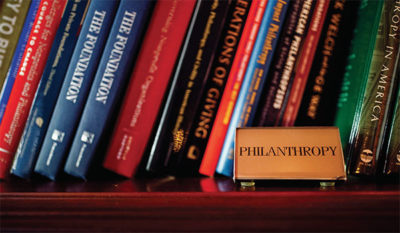 The stately and expansive Arthur M. Blank Family Office is filled with Atlanta Falcons mementos and art honoring Native Americans. The office’s library is stocked with books on philanthropy and leadership.
The stately and expansive Arthur M. Blank Family Office is filled with Atlanta Falcons mementos and art honoring Native Americans. The office’s library is stocked with books on philanthropy and leadership.
Lisa Chang, the senior vice president and chief human resources officer for Blank’s businesses, known collectively as the AMB Group, saw firsthand Blank’s attitude after the loss. “The day after the Super Bowl, we were on to the next thing,” she says. That didn’t surprise her. Blank is always encouraging his employees to keep trying, to keep moving. “There is no finish line” is one of his mantras. “Just when we think we got the cherry on top, he pushes us further,” Chang says.
Blank and the Falcons moved on in a big way from the Super Bowl with the opening of the 2-million-square-foot Mercedes-Benz Stadium, which also is home to the Atlanta United soccer team. “This is a very iconic and unique stadium,” says Blank, “probably the finest sports entertainment complex in the country today.” That may not be an exaggeration. When Blank and his team began the initial planning of the stadium about 10 years ago, the vision was to create something bold. Seating 71,000 fans for football games, it features a 58-foot-tall, 360-degree video board and a retractable roof with eight massive interlocking panels. For those feeling thirsty, the stadium has 1,200 beer taps.
In the weeks before the stadium opened, Blank focused on making sure it had a welcoming atmosphere for fans. The stadium employs a staff of 4,000, and Blank surprised newly hired ushers and concessionaires by showing up for their training sessions. “The grandeur of the building needs to be matched by the grandeur of our associate services,” Blank says. “We want our guests to feel like this is their home.”
A History of Building
Blank may have just built a stadium, but the first act of his career was spent building Home Depot, which he co-founded in 1978. When he stepped down from the ubiquitous home-improvement store in 2001, the company was the second largest retailer in the world after Walmart. “I had a wonderful 23 years,” Blank says, “and I was ready to do some other things.”
David Homrich, who has known Blank for 28 years, remembers the entrepreneur’s mindset as he left the company, with the possibility of new opportunities stretched before him. “In some respects, he was like a caged tiger,” Homrich says. “He wanted to run.” Homrich had served as Blank’s financial planner for 12 years before coming to work for him full time, and today he is the executive vice president, chief financial and investment officer of the AMB Group. The pair were having dinner together when Blank shared the news that he was leaving Home Depot. Homrich asked what the entrepreneur planned to do next. “I don’t know,” Blank replied, “but I know I’ll be active.”
A year later, Blank bought the Falcons, and since then he has found himself in the middle of the biggest spectacle in America: NFL football. Game days are filled with noise, cameras, and crowds, but Blank tries not to bother with all the pageantry. As an owner, he’ll socialize with sponsors, supporters, and officials at halftime and before the game, but during the game, he holes up with team executives and focuses on the field. He wants no distractions. “I’m an intense fan,” he says.
Before games, Blank also likes to visit with players on the field and in the locker room. “I try to spend a lot of time with our players, getting to know them, their families, their passions in life,” he says. When he chats with players, Blank aims to stay away from football talk. Because the average NFL career is only three years, he is concerned about their future plans. “They’re trying to figure out, ‘What do I do with the rest of my life?’” Blank says. “It’s hard.”
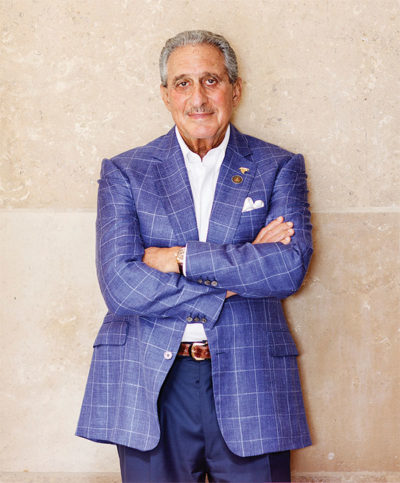
As the owner of a professional football team and soccer team, Arthur Blank believes in the power of sports to bring people together. “It’s a great venue for that,” he says. “You act as a catalyst for building community.”
While the Falcons’ head coach and general manager keep him informed about their strategies for the team, Blank gives them a wide berth. “I want to stay out of their way,” he says. “I don’t give any direction to any of our football staff on the draft, free agency, games, etc.” After games, he’ll meet with the coach for a debriefing, but not until the next day. “I don’t meet with him the day of the game, because it’s just too emotional, win or lose,” Blank says.
Beyond what happens on the field, Blank also focuses on the role that the Falcons play in the community. “It’s important for the team to give back, to win on the field and win off the field,” Blank says. “The expression we’ve always used is that there are two Super Bowls every year. The first is the one that you traditionally play on the field. The other is the Super Bowl of life. We want to win that one every year.”
The Art of Philanthropy
This drive to give back can be seen in Blank’s commitment to Atlanta’s Westside. An area plagued by poverty and high unemployment that lies next to the new stadium, the Westside once was home to civil rights leaders Julian Bond and Martin Luther King Jr. “Arthur said from the beginning that we could not have this iconic stadium on one side of Northside Drive and have these depressed neighborhoods on the other side,” says Penelope McPhee, president and director of the Arthur M. Blank Family Foundation. “We had to make a difference to the whole community.”

 Photos Courtesy of the AMB Group
Photos Courtesy of the AMB Group
Mercedes-Benz Stadium, the new home of the Atlanta Falcons, opened this football season. Costing $1.6 billion, the stadium features a uniquely designed retractable roof that employs eight massive interlocking panels.
To do that, Blank has invested millions in helping the Westside. As a deal to build the new stadium was finalized in 2013, the Blank Family Foundation pledged $15 million to the Westside Neighborhood Prosperity Fund, which invests in workforce development, education, housing, and other areas. This September, the foundation added another $15 million. The new stadium includes a 1.2-million-gallon underground vault to collect rain water, which helps alleviate flooding problems in the Westside. Other foundation initiatives, such as the Inspiring Spaces program that focuses on preserving and enhancing green spaces, have spent an additional $7 million on Westside activities. Plans in the near future include the creation of a neighborhood park on the site of the soon-to-be-demolished Georgia Dome.
All this investment has sparked corporations and other foundations to make their own donations to the Westside. “The vision has always been that we would be a catalyst, and others would invest with us,” McPhee says. The help is needed. Transforming neighborhoods and lifting people out of poverty isn’t easy. “It’s easier to build a stadium,” Blank says. “Changing people’s lives is a tougher row to hoe, but we’re working on it.”
Blank’s efforts in the Westside are just one part of his philanthropic aspirations. Since its founding in 1995, the Blank Family Foundation has contributed more than $300 million to organizations working in education, early childhood development, the environment, and the arts. That commitment will only grow with Blank’s signing of the Giving Pledge and his promise to donate the bulk of his money to the foundation. Contending that the “art of philanthropy, in many ways, is more difficult than the art of making money,” Blank spends considerable time evaluating nonprofits and figuring out the most effective programs to support.
Blank’s generosity extends to his alma mater as well. Through the years, he has sponsored scholarships, established an endowment to support the College’s entrepreneurship program, and funded Social Innovation Inventureships, which allow Babson students to tackle projects that make a social impact. The College left its mark on Blank, too. He remembers fondly his old professors, and he credits the campus offices he held for helping him grow as a leader. “Clearly, the education he received at Babson is in his DNA,” McPhee says. “He truly is, in the business area and in the philanthropic area, a serial entrepreneur. His vision is limitless. That reflects on the values of Arthur, but that also reflects on the values of Babson, too.”
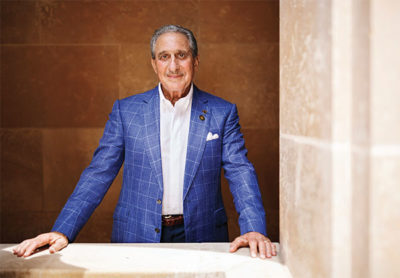
Arthur Blank continues to find inspiration in his work and philanthropy. “Making a difference in the people we serve,” he says, “that’s what gives me the energy to do what I’m doing.”
All six of Blank’s children, including his youngest, twins who are 16, are involved in the family foundation to some degree. Spending as much time as he can with his family, which includes six grandchildren, is important to him. His wife, Angela, also has three children. In his conference room, a collage of family pictures fills the wall behind him. “I’ve got a lot of people to keep track of,” he says.
As busy as he is, Blank has taken some steps back from the day-to-day operations of his for-profit businesses, hiring a CEO in late 2015 for the AMB Group, though Blank continues as chairman and remains heavily involved in strategy. When asked if he has any plans to step aside fully, he states simply, “No.” He still has the drive to move, to plan, to act. “I probably always will,” he says.
]]>When MOOCs burst onto the scene almost 10 years ago, they were greeted as higher education’s savior—or its downfall. The free online classes held out the promise of bringing college within reach of anyone with internet access. But some observers feared that access could undermine the traditional college model. Nonetheless, many colleges and universities got on board. Both the dire predictions and the overblown promises have yet to be realized, but one thing remains clear, says Parise: “MOOCs are not going away.”
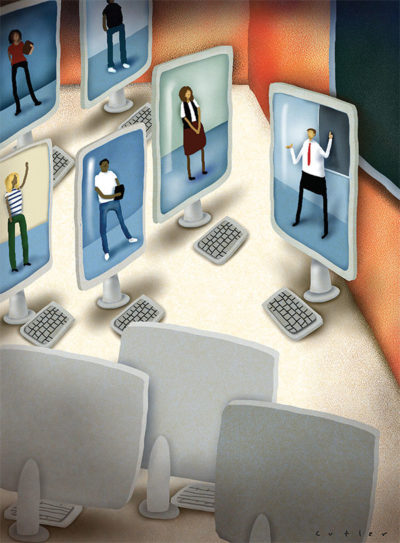
Illustration: Dave Cutler/theispot.com
EdX began as a collaboration between MIT and Harvard and is now a leading provider of online courses, with more than 70 schools on board. Babson joined edX because it offered the support and reach the College sought in the MOOC marketplace. The first six courses that Babson is offering—a basic business suite covering such topics as financial analysis, marketing fundamentals, and the entrepreneurial mindset—were launched in January.
Translating Babson’s content into online courses proved to be no easy matter—even for those who have created digital content for the College’s blended learning programs. “I thought it would be a simple migration,” says Mark Potter, professor of finance. “And that was wrong.” One big difference, he says, is the sheer size of the classes: 50 or so in a blended learning MBA class, compared with perhaps 5,000 in a BabsonX class. BabsonX classes are designed to run both “live,” in real time, and “self-paced.” But even in live classes, it simply isn’t possible to interact with every student. So professors connect with students beyond the “classroom” through discussion boards, which Potter says he enjoyed, spending a couple of hours a day on the boards during the four weeks of his live class.
The static nature of online material also proved a challenge. “During a typical class, I like reading students’ reactions and adapting on the fly,” Potter says, “and all of a sudden, I’m talking to a camera.” But Potter says the academic technologies team, headed by Eric Palson, has done an exemplary job of designing and creating content in partnership with faculty members. It’s not just a matter of pointing a camera at a professor and letting him or her talk, says Palson. “That can get very boring, very fast,” he says. His team works with faculty to create graphics, animated segments, and more to ensure the courses are visually compelling as well as intellectually engaging.
Creating the online courses represents an investment of time, money, and resources. But supporters of the effort cite a slew of potential benefits for the College, from raising awareness about Babson to increasing enrollment to connecting with alumni to providing prerequisites for admitted grad students to sharing the College’s mission. Although the program is still in its early stages, by those measures it’s already a success. Says Potter: “We can reach so many people who wouldn’t ordinarily get touched by Babson’s curriculum and staff. The investment was a pretty small price to pay.”—Jane Dornbusch
]]>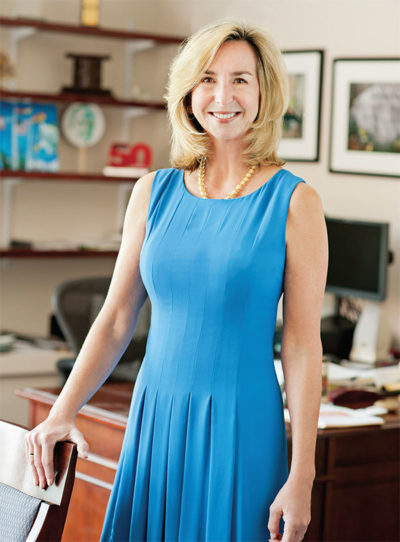
Photo: Webb Chappell
Babson President Kerry Healey
In 1919, when Babson was founded, classes were held at Roger Babson’s home on Abbott Road in Wellesley. Two years later, Roger purchased 125 acres of farmland to serve as the future campus for the young school, and in the nearly 100 years since, that campus has continued to grow and evolve. This fall, as I inducted members of the Class of 1967 into the Half-Century Club (one of my favorite events), many of those alumni remarked that they barely recognized the Babson campus—it has been so transformed over the past 50 years.
Today, we are embarking on our next wave of transformations and planning a campus for our second century.
In September, we broke ground on a new recreation and athletics center. This project is among the most ambitious ever undertaken by Babson. When completed, it will provide a venue for events and recreation, a place for members of our entire campus community to invest in their health and well-being, and a beautiful new home for Babson Athletics and our incredible scholar athletes (see “New Construction Project to Transform Campus Life”).
The Weissman Foundry, which also broke ground in September, will be a flexible maker space focused on hands-on experimentation and prototyping. Designed with input from Olin College, it is envisioned as a cross-campus workshop where entrepreneurs of all kinds can collaborate, turn ideas into action, and create tomorrow’s products and enterprises (see “A Hands-On Space for Students to Innovate”).
The Weissman Foundry is particularly special because it is named in honor of esteemed Babson alumnus and trustee Robert Weissman ’64, H’94, P’87, ’90, and his wife, Jan, P’87, ’90. This fall, we were delighted to announce that the Weissmans made a $36.6 million gift to Babson, bringing their lifetime support to a record $100 million. We are deeply grateful for the Weissmans’ commitment to our community and belief in Babson’s unique ability to advance entrepreneurship everywhere.
A portion of their gift will enable us to construct a new learning common and gateway to Horn Library, featuring a four-season garden, a cafe, collaborative work areas, informal gathering spaces, and a new home for the Stephen D. Cutler Center for Investments and Finance. It also will serve as a central location for Babson’s academic and extracurricular resource centers and provide additional classroom and office space.
As we approach our Centennial, we are excited to further create spaces that will enable Babson to remain the global leader in entrepreneurship education, attracting the best and brightest students from around the world, providing an unmatched student experience, and educating entrepreneurial leaders who will change the world for the better.

Kerry Healey
]]>